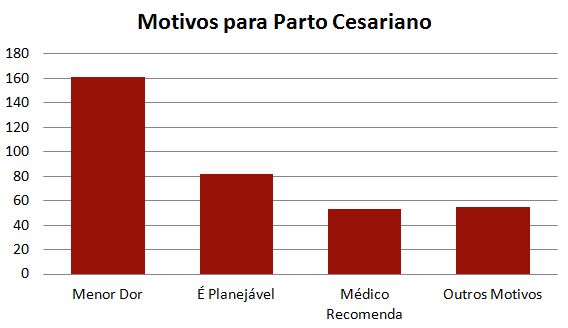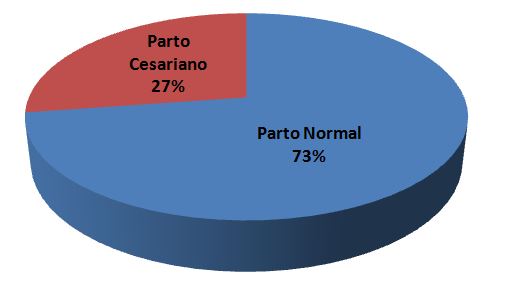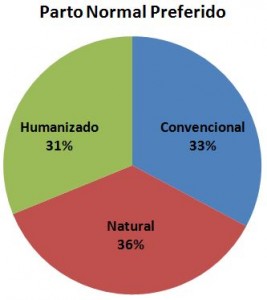Before we become mothers, we have to face what, for many, seems like a big unknown that comes down to the question: normal birth or cesarean? Influenced by our own mothers, friends, doctors, and information from the media, each of us forms our own preference for childbirth. But are we really well informed and, more importantly, is our will respected?
To find the answer, we conducted a survey with 1,011 frequent visitors of Famivita, which revealed that 73% of Brazilian women prefer normal birth while 27% opt for a cesarean. Comparing this result with the Ministry of Health’s childbirth statistics, it’s clear that something is very wrong here. Nearly 57% of the 2.9 million Brazilian boys and girls born in 2013 saw the light for the first time through a cesarean delivery. This percentage has been increasing constantly for decades, making Brazil the world champion in this category.
According to information from the World Health Organization, a cesarean is advantageous and therefore necessary for the health of the mother and baby in only 15% of deliveries. Counting the women who prefer normal birth but need to have a cesarean for medical reasons, and assuming every woman who prefers a cesarean is able to have one, the rate of cesarean deliveries should not exceed 38% under any circumstances. This means that almost one in every five Brazilian women has her preference disregarded, or 19%. Even in the public system, where the rate has already surpassed 40%, there is an excess. To reach the national average, we can only conclude that the excess in private healthcare is much greater, approaching 90%.
Origins of the Increase in Cesarean Deliveries
It was not hard to find a starting point to identify the origins of this problem—my own childbirth stories. The “cesarean or normal birth” question always had a simple answer for me: I wanted to have a normal birth! Do you know what ended up happening? None of my three children were born naturally. That doesn’t mean I was completely disrespected because in my girls’ cases it was unavoidable. Joana’s birth was a true emergency because there was no more amniotic fluid and a serious infection was already setting in. In Melissa’s case, it was the result of pre-eclampsia, which could have led to dangerous high blood pressure, not to mention the risk of eclampsia in a possible future pregnancy, which would bring a host of risks for both me and the baby. So, understandably, the doctor opted for a cesarean.
Now, Eduardo’s birth was different. There was no need, and it really was possible to go through with a normal birth. But that only became clear to me later, after talking to another obstetrician. I arrived at the maternity at 9 a.m. at 41 weeks of pregnancy. Labor symptoms had already started some time ago, but Dudu simply didn’t want to come out. Since I wanted a normal birth, the doctor began to stimulate labor. While amniotic fluid was coming out—since they broke my water—the dilation was not progressing. In the afternoon, the obstetrician made the decision, without informing me, to carry out a cesarean, saying my baby would not pass through the vaginal canal. Today it seems clear to me there was another motive that influenced it: the doctor’s convenience in avoiding complications and ending his shift on time. But what could I do?
As you can imagine, the doctor plays a crucial role in deciding whether a delivery will be normal or cesarean. Beyond convenience, the cesarean also has another advantage, both for the doctor and the patient—it is schedulable. For pregnant women, this is the second most cited reason for choosing this type of delivery. For clinics, the explanation may be economic, especially considering the sky-high rates in private healthcare. It is possible to earn amount X in Y time—a marvel from a profit point of view. Supporting a woman through a normal labor for several hours is simply less attractive and also less practical from the professional’s perspective. Doctors’ reasons for supporting cesarean delivery are also reflected in the advice they give their patients—a reason also cited by participants in our survey.

The strongest argument against normal birth is pain. And who wouldn’t be scared at the thought that an entire baby has to pass through the narrow vagina? Just by looking and the scenes on television, it seems you can already feel the pain, not to mention the comments from friends, mothers, women who went through the experience without pain medication. But have you ever thought that your mental simulation of the pain might be stronger than the real thing? The female body is fully capable of naturally giving birth to a child. That doesn’t mean a normal birth doesn’t hurt—it does, but to really know, you have to experience it, and every woman feels labor pain differently.
The “worst” moment is the intense contractions, which, not even with epidural anesthesia, can be completely avoided, and they’re usually worse than the actual moment the baby is coming out. It’s also possible to reduce labor pain with psychological and physical preparation. And after all, what many women forget when thinking about the pain of normal childbirth is that a cesarean, despite the anesthesia, also brings pain—after delivery. The recovery time from a cesarean is typically a few weeks, while some women who give birth vaginally can walk and care for their baby on the very same day.
Myths About Normal Birth After Cesarean
The “normal vs. cesarean” question doesn’t exist just for the first delivery but can and should be present for all births. While it is well known that a woman who has had a normal birth can have a cesarean, the inverse is a major myth in many women’s lives. They believe they cannot have a normal birth after a cesarean. Women who had a first cesarean delivery can, in fact, have a normal birth in a new pregnancy. Usually, the most common excuse for second-time moms involves the fact there was previously a surgery. But no, a normal birth after a cesarean is perfectly possible.
A normal birth is also possible in a third pregnancy after two cesareans. However, this demands greater care from the obstetrician looking after the mother. Theoretically, any signs of labor would mean a higher risk that the scars from previous cesareans might rupture, because the incision already stretched by the current pregnancy would be fragile. Still, vaginal delivery is possible. You just should not attempt a normal birth at home and before term after two cesareans, as you will need resources on hand for any eventuality. The woman should also be in good health and have controlled blood pressure for labor to proceed normally.
As a safety measure, a woman can have up to three cesarean deliveries. After the fourth, risks related to the pressure on the scar increase significantly, putting the pregnancy as a whole in danger. On the other hand, normal birth can be carried out several times without such limitations. We only have to look at women from earlier times who had 10, 12, or sometimes even more children when their fertility allowed.
Preferences and Differences in Normal Birth
While the patient having a cesarean basically places herself completely in the hands of the obstetrician, that’s not necessarily the case for normal birth. Two-thirds of the participants in our survey expressed a desire to have a birth different from the conventional ones performed in hospitals around the country; in other words, a humanized or natural birth. For the purpose of analysis, let’s understand the following definitions of normal birth:
- Conventional – performed with pre-planned medical intervention
- Humanized – performed with intervention only if expressly requested by the mother
- Natural – performed with no intervention at all
Currently, there are no conclusive statistics on humanized and natural births carried out in Brazil. Even assuming some women weren’t 100% familiar with these definitions when answering, and there may be changes of opinion at the time of delivery, you don’t need to visit every maternity hospital in Brazil to know that reality is far from what Brazilian women want. Certainly, less than 31% of normal births are humanized, even due to a lack of preparation in most facilities for such care.
Thanks to the mobilization of Brazilian women advocating for their right to have their wishes respected, greater exposure of the issue in the media (like on YouTube for example), and the resulting increased attention, there are signs that this situation could change. More and more maternity wards are willing to follow the example of reference institutions to support women and enable free choices.
How to Secure the Birth You Want
I consider a happy ending to be a birth where everything goes well, both mother and baby are healthy, and the woman’s wishes are respected. This survey showed us that, above all, the latter is still far from reality. Many women truly want to experience one of the best moments of their lives naturally, just like their mother, grandmother, and great-grandmother. For this to be possible, it is important for professionals to be conscious of what is best for both patient and baby and be open to listening to you. Talk with your obstetrician (who will likely accompany your delivery) ahead of time about the possible methods of childbirth, your fears, and your wishes. If you’re in the fortunate position to choose (and I know many women are not, due to lack of options), look for alternatives if you don’t feel you have the perfect fit.
A cesarean certainly saves lives, but there are many, many cases in which it is completely unnecessary, especially in situations where force or opportunistic and irrelevant excuses are used. It’s no coincidence that Brazil leads the world in cesareans. The hope is that the initiative taken by the Federal Government, which requires doctors to justify their choice for a cesarean (under penalty of a R$25,000 fine per case), will strengthen our position as patients. Since the doctor enjoys such trust from women, why couldn’t he suggest a normal delivery? There is no doubt it is better for both mother and baby, since in vaginal birth, secretions are expelled through the cervical canal, and it also facilitates the mother’s post-partum recovery.
To have the normal birth you desire, conditions must also be favorable. For a humanized birth, it is often advantageous to have a birth plan. You also need a doctor who supports you 100% because, without that, the birth will never go as you imagined. Feeling calm is fundamental at this time, so confidence in the professional who will accompany you is most important. The same goes for home birth.
But it’s not just external factors that decide if the birth will be the one you’ve dreamed of. We need to be prepared both psychologically and physically. For a normal birth, a woman can eat properly and exercise daily to facilitate dilation, avoid excessive weight gain during pregnancy, and prevent severe health problems. With your doctor’s approval, women who want a normal birth can do swimming, yoga, and Pilates. If you were an athlete before pregnancy, your pace should be reduced.
Photos: Personal Archive TF













